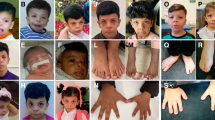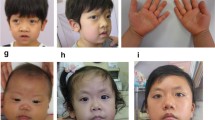Abstract
The main purpose of this study was to describe a novel missense mutation (p.D179H) found in a Western Sicily family and to examine the genetic and audiologic profiles of all family members by performing a GJB2 and GJB6 mutations analysis and a complete audiologic assessment. The proband was a 3-month-old infant with a congenital profound sensorineural hearing loss; direct sequencing of the GJB2 revealed the presence of a c.35delG mutation in the heterozygous state and a heterozygous G>C transition at nucleotide 535 in trans; this novel mutation, called p.D179H, resulted in an aspartic acid to histidine change at codon 179. It was also evidenced in the heterozygous state in two members of this family, both with normal hearing. No GJB6 mutations were evidenced in all subjects studied. Considering the genotypic and phenotypic analysis of all family members, we suggest, differently from the p.D179 N mutation previously reported, a recessive mode of inheritance. Functional studies on p.D179H have to be performed to confirm our hypothesis.


Similar content being viewed by others
References
Del Castillo FJ, Del Castillo I (2011) The DFNB1 subtype of autosomal recessive non-syndromic hearing impairment. Front Biosci 16:3252–3274
Forge A, Becker D, Casalotti S (2003) Gap junctions in the inner ear: comparison of distribution patterns in different vertebrates and assessment of connexin composition in mammals. J Comp Neurol 467:207–231
Wangemann P (2002) K + cycling and the endocochlear potential. Hear Res 165:1–9
Beltramello M, Piazza V, Bukauska FF, Pozzan T, Mammano F (2005) Impaired permeability to Ins(1,4,5)P3 in a mutant connexin underlies recessive hereditary deafness. Nat Cell Biol 7:63–69
Del Castillo FJ, Rodríguez-Ballesteros M, Alvarez A, Hutchin T, Leonardi E et al (2005) A novel deletion involving the connexin-30 gene, del(GJB6-d13s1854), found in trans with mutations in the GJB2 gene (connexin-26) in subjects with DFNB1 non-syndromic hearing impairment. J Med Genet 42:588–594
Del Castillo I, Villamar M, Moreno-Pelayo MA, Del Castillo FJ, Alvarez A et al (2002) A deletion involving the Connexin 30 gene in nonsyndromic hearing impairment. N Engl J Med 346:243–249
Wilch E, Zhu M, Burkhart KB, Regier M, Elfenbein JL et al (2006) Expression of GJB2 and GJB6 is reduced in a novel DFNB1 allele. Am J Hum Genet 79:174–179
Wilch E, Azaiez H, Fisher RA, Elfenbein J, Murgia A et al (2010) A novel DFNB1 deletion allele supports the existence of a distant cis-regulatory region that controls GJB2 and GJB6 expression. Clin Genet 78:267–274
Primignani P, Castorina P, Sironi F, Curcio C, Ambrosetti U et al (2003) A novel dominant missense mutation–D179 N–in the GJB2 gene (Connexin 26) associated with non-syndromic hearing loss. Clin Genet 63:516–521
American Academy of Pediatrics, Joint Committee on Infant Hearing (2007) Year 2007 position statement: Principles and guidelines for early hearing detection and intervention programs. Pediatrics 120:898–921
Martines F, Porrello M, Ferrara M, Martines M, Martines E (2007) Newborn hearing screening project using transient evoked otoacoustic emissions: western sicily experience. Int J Pediatr Otorhinolaryngol 71:107–112
Martines F, Bentivegna D, Ciprì S, Costantino C, Marchese D et al (2012) On the threshold of effective well infant nursery hearing screening in Western Sicily. Int J Pediatr Otorhinolaryngol 76:423–427
Martines F, Salvago P, Bentivegna D, Bartolone A, Dispenza F et al (2012) Audiologic profile of infants at risk: experience of a western sicily tertiary care centre. Int J Pediatr Otorhinolaryngol 76:1285–1291
Salvago P, Martines E, Martines F (2013) Prevalence and risk factors for sensorineural hearing loss: western sicily overview. Eur Arch Otorhinolaryngol. doi:10.1007/s00405-013-2379-2
Cryns K, Orzan E, Murgia A, Huygen PL, Moreno F et al (2004) A genotype-phenotype correlation for GJB2 (connexin 26) deafness. J Med Genet 41:147–154
Snoeckx RL, Huygen PL, Feldmannl D, Marlin S, Denoyelle F et al (2005) GJB2 mutations and degree of hearing loss: a multicenter study. Am J Hum Genet 77:945–957
D’Andrea P, Veronesi V, Bicego M, Melchionda S, Zelante L et al (2002) Hearing loss: frequency and functional studies of the most common connexin26 alleles. Biochem Biophys Res Commun 296:685–691
Shahin H, Walsh T, Sobe T, Lynch E, King MC et al (2002) Genetics of congenital deafness in the Palestinian population: multiple connexin 26 alleles with shared origins in the Middle East. Hum Genet 110:284–289
Yum SW, Zhang J, Scherer SS (2010) Dominant connexin26 mutants associated with human hearing loss have trans-dominant effects on connexin30. Neurobiol Dis 38:226–236
Zhang J, Scherer SS, Yum SW (2011) Dominant Cx26 mutants associated with hearing loss have dominant-negative effects on wild type Cx26. Mol Cell Neurosci 47:71–78
Conflict of interest
The authors declare that they have no conflict of interest.
Author information
Authors and Affiliations
Corresponding author
Rights and permissions
About this article
Cite this article
Bartolotta, C., Salvago, P., Cocuzza, S. et al. Identification of D179H, a novel missense GJB2 mutation in a Western Sicily family. Eur Arch Otorhinolaryngol 271, 1457–1461 (2014). https://doi.org/10.1007/s00405-013-2613-y
Received:
Accepted:
Published:
Issue Date:
DOI: https://doi.org/10.1007/s00405-013-2613-y




